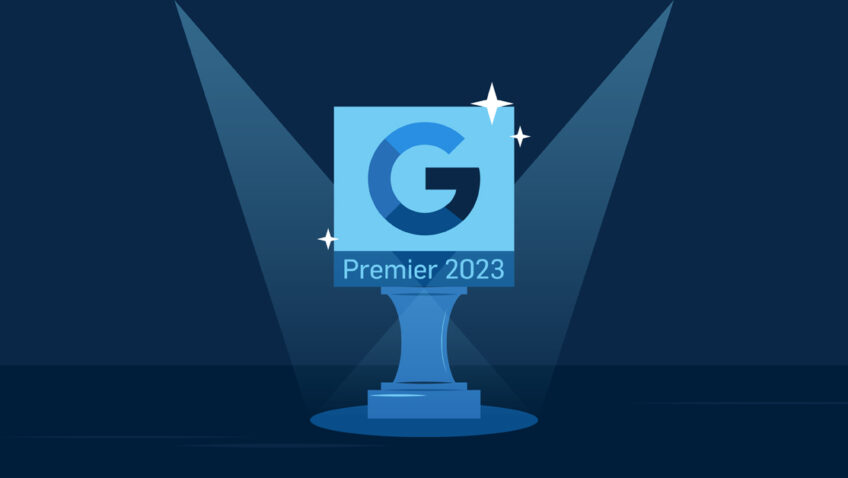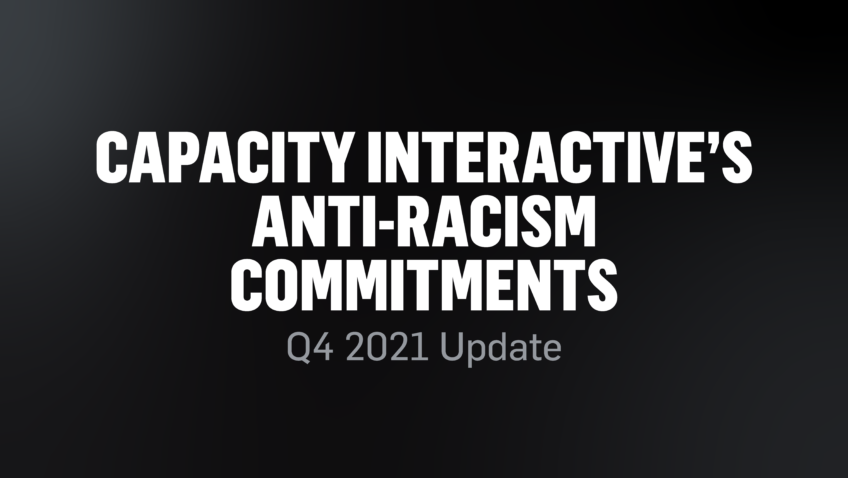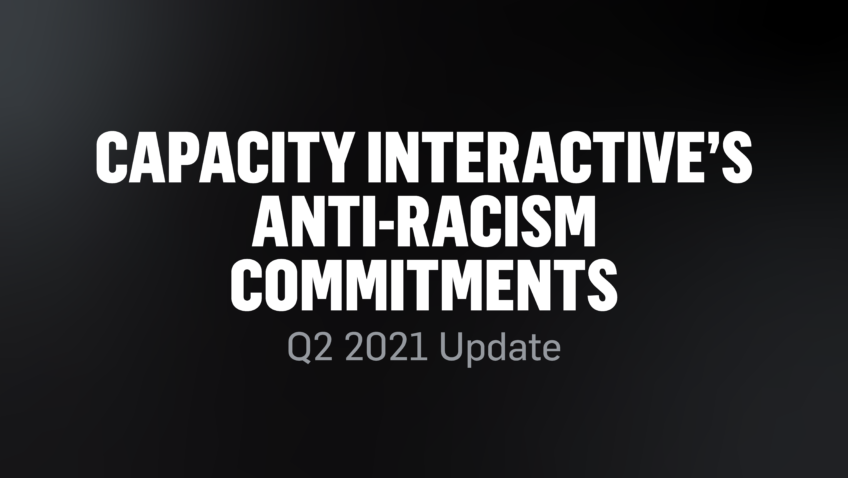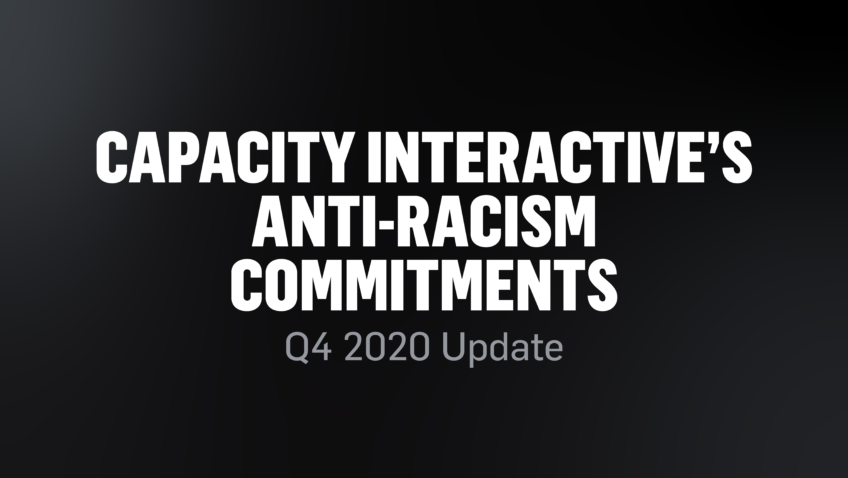CI’s Anti-Racism Commitments: Q1 2021 Update
Capacity Interactive (CI) created and published a list of Anti-Racism Commitments in June 2020. This public statement outlined our action plan for becoming an anti-racist organization and served as an accountability mechanism. As a part of this statement, we committed to reporting on our progress (you can see our update from Q4 2020 here!)
This blog post highlights our progress from Q1 2021—I hope it sparks inspiration and courage to enact necessary change at your organization.
Keeping ED+I Work Prioritized
As arts organizations reopen, our goal is to ensure that no matter how busy we are at CI, we keep our ED+I work prioritized. How do we do this? I don’t have any one-size-fits-all answers, but I’m happy to share some of what we’re doing.
First, we’ve decided to temporarily move our Arena Team meetings from a weekly to a biweekly schedule. (As a reminder, the Arena Team is a committee that decentralizes decision-making at CI and is open to any team member). It’s a small but simple change that allows Arena Team members breathing room and time to participate in meaningful ways. We’ll re-evaluate our meeting schedule at the end of Q2 when we’ll hopefully have a few new members on our team
(did I mention we’re hiring?).
Evaluating How Arena Team Work is Accomplished
We’ve also taken a step back and evaluated how Arena Team work gets accomplished. In the past, we’ve formed a new committee or task force to add more voices to decision-making processes.
In theory, this idea works, but as our team continues to grow and schedules get busier, the addition of brand new committees isn’t always sustainable. The question now becomes, how do we incorporate a commitment to anti-racism in our decision-making processes without requiring a large group of people to meet? Are there decisions made by smaller groups of people using a framework or set of guiding questions instead?
I don’t have anything concrete to report yet, but I wanted to share this thought process as it might resonate with you at your organization. I hope to share more insight in the coming months. But in the meantime, I’ve rounded up the highlights from our Arena Team’s progress this quarter.
What We’re Working On
Here’s a rundown on what The Arena Team has been working on in Q1 2021.
Clients and External Committee
This committee handles our relationships with clients and external-facing events, such as Boot Camp and CI to Eye Live.
Digital Marketing Partnership Grant: We aim to roll out applications for a Partnership Grant later this year. It’s a program that offers a block of pro-bono CI consulting hours to arts organizations that primarily serve BIPOC communities, are BIPOC-led, or whose mission is rooted in fighting for racial justice. If you’re part of CI’s email list, you’ll be the first to know about this new grant. If you’re not, sign up at the bottom of this post!
Education and Professional Development Committee
This committee creates internal educational touchpoints.
Anti-Racism Mixed Media Club: We continue to host regular discussions around a curated selection of articles, podcasts, and books. In February, we read and discussed a collection of articles, including To Make Orchestras More Diverse, End Blind Auditions, Musicians on How to Bring Racial Equity to Auditions, Orchestras Are Rushing Add Black Composers. Will It Last? Are We Hearing A Crescendo of Anti-Racism in Classical Music? with Dr. Kira Thurman and Ashleigh Gordon, and Timeline: A History of Black Classical Musicians. In April, we watched and discussed the HBO documentary Black Art: In the Absence of Light.
Onboarding: As we welcome new employees to CI, we now include our Anti-Racism commitments, goals, and ways to get involved in our formal onboarding process.
Hiring and Promotions Committee
This committee examines our hiring and promotions processes to create systems with more diverse stakeholders.
Internal Job Descriptions: We created and released updated internal job descriptions for Junior Analyst and Analyst roles. These job descriptions are structured to provide both clarity and flexibility (a very tricky line to toe, we have found). We leaned heavily on For Your Improvement to guide us. It’s a reference text developed by behavioral scientists that details measurable characteristics (or competencies) that make someone successful in their role.
The result is a framework that helps employees and managers benchmark their performance and guide promotions. We plan to release internal job descriptions for all consulting positions by the end of Q2 before moving on to our Marketing, Operations, and Senior Leadership job descriptions.
External Job Postings: We’ve added several new sections to our external job descriptions to keep the hiring process more transparent.
We’re now including compensation and a description of the hiring process (including who is conducting interviews and a timeline). We’ve also adjusted our cover letter request to a more general “expression of interest,” which can take many forms: a written cover letter, a video, or an audio file.
Internal Accountability Committee
This committee examines internal policies and systems, breaks them down, and rebuilds them.
Employee Performance Reviews: We completed a significant overhaul of our employee performance review process, focusing on an explicit framework that highlights employee growth and the path to promotions. We incorporated the SMART Goals framework, which facilitates specific, measurable, achievable, relevant, and time-bound goals.
We also devised an explicit structure to guide the “employee to manager” review conversation:
Taking Stock: What are you bringing into the conversation today? How are you feeling? What biases might you be bringing in with you?
Guided Questions: Highlight the employee’s experience and performance over the previous term, and an explicit question about the employee’s work towards a promotion (if applicable).
Finally, we standardized our review process. CI reviews now occur during two explicit review periods per year, rather than being tied to each employee’s start date. This creates greater accountability for managers and employees to schedule and complete reviews and sets more explicit expectations for everyone involved.
We are by no means experts in any of this work. We have made mistakes, and we’ll continue to make mistakes as our work continues. Yet, as another quarter progresses, I’m incredibly proud of what we’ve accomplished.
If something resonates with you, or if you have feedback for us, I’d love to hear it.
We’re committing to publishing these updates every quarter—I look forward to sharing our progress with you at the end of Q2 2021.










